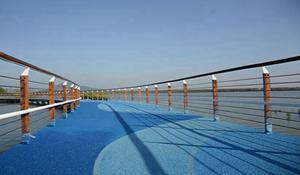Permeable Pavement The best sublayer is a gravel sublayer, while a poor one is a clay layer. Traditional impermeable pavements often have drainage systems set within their base layers. Even if water flows through the surface layer, it will be drained away by the drainage system, preventing damage to the sublayer. Therefore, traditional hardened pavement sublayers only need to meet compaction standards to satisfy load-bearing requirements, with no other requirements. This is insufficient for permeable pavements. Below, we introduce the performance characteristics of permeable pavements.
1. High permeability: Permeable pavement has 15%-25% voids, allowing a permeability rate of 31-52 liters/meter/hour, far exceeding the drainage rate under effective rainfall configurations.
2. High load-bearing capacity: According to national testing agencies, the load-bearing capacity of permeable pavement can fully meet the standards for C20-C25 concrete, which is higher than that of general permeable bricks.
3. Good aesthetic effect: Permeable pavement offers optimized color proportioning schemes, allowing designers' unique creativity to realize various decorative styles required by different environments and personalities. This is difficult to achieve with general permeable bricks.
4. Easy maintenance: Concerns about pore clogging are unnecessary, as the unique permeable paving system can be easily resolved with high-pressure water cleaning.
5. Freeze-thaw resistance: Permeable pavement has stronger freeze-thaw resistance than general concrete pavements and will not crack due to freeze-thaw cycles because its structure possesses larger voids.
6. Durability: The durability and wear resistance of permeable pavement exceed that of asphalt and are close to that of regular pavements, avoiding the disadvantages of general permeable bricks, such as short service life and lack of cost-effectiveness.
7. High heat dissipation: The material has a low density (with 15-25% voids), which reduces heat retention capacity. The unique pore structure allows lower underground temperatures to be transferred to the surface, thereby lowering the temperature of the entire paved surface. These characteristics make permeable pavement comparable to natural vegetation-covered surfaces in terms of heat absorption and retention.
Permeable Pavement possesses inherent high permeability and breathability, freeze-thaw resistance, acid rain resistance, groundwater replenishment, and microclimate regulation. The ecological permeable pavement system is an effective solution for groundwater replenishment and alleviating urban heat island effects.













